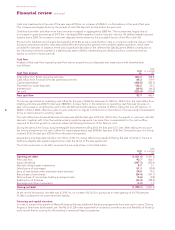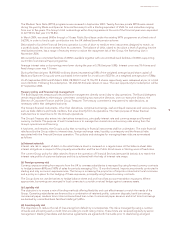Marks and Spencer 2004 Annual Report Download - page 20
Download and view the complete annual report
Please find page 20 of the 2004 Marks and Spencer annual report below. You can navigate through the pages in the report by either clicking on the pages listed below, or by using the keyword search tool below to find specific information within the annual report.
A Save As You Earn (SAYE) Option Scheme was approved by
shareholders in 1981 and renewed by shareholders in 1987
and 1997. Inland Revenue rules limit the maximum amount
saved to £250 per month. When the savings contract is
started, options are granted to acquire the number of
shares that the total savings will buy when the contract
matures. Options cannot normally be exercised until a
minimum of three years has elapsed.
Shareholding policy
A requirement was introduced in 2002 that the executive
directors, within five years of 1 June 2002 or within five years
of appointment (whichever is the later), should hold shares
whose market value at that time is equivalent to or greater
than their then current gross annual base salary. Under these
rules, all current executive directors have sufficient holdings
in the Company to be able to comply with this requirement.
The Marks & Spencer Pension Scheme
Executive directors and all employees with a permanent
appointment date prior to 1 April 2002 are eligible to
participate in the Company’s Defined Benefit Pension
Scheme. The Scheme is non-contributory and the subject of
an Independent Trust. The normal retirement age under the
Pension Scheme for senior management is 60 to harmonise
with the Company contractual retirement age.
The Pension Scheme enables members to achieve the
maximum pension of two-thirds of their salary in the
12 months ending at normal retirement date after 30 years’
service. For employees who joined the Scheme prior to
1 January 1996, no actuarial reduction is applied to pensions
payable from the age of 58. Employees who joined the
Scheme on or after 1 January 1996 are subject to an
actuarial reduction in their pension if payment starts prior
to their normal retirement date.
In the case of earnings over £100,000 p.a., the pensionable
salary is usually based on an average of the earnings over
the last three years to retirement.
Pension commutation to enable participants to receive
a lump sum on retirement is permitted within Inland
Revenue limits.
For death before retirement, a capital sum equal to four
times salary is payable, together with a spouse’s pension of
two-thirds of the member’s prospective pension at the age
of 65 (60 for senior management). For death in retirement,
a spouse’s pension is paid equal to two-thirds of the
member’s current pension. In the event of death after
leaving service but prior to commencement of pension,
a spouse’s pension of two-thirds of the accrued preserved
pension is payable. In all circumstances, children’s
allowances are also payable, usually up to the age of 16.
Substantial protection is also offered in the event of serious
ill health.
Post-retirement increases for pensions earned from 6 April
1997 are awarded on a statutory basis. Pension earned prior
to 6 April 1997 are guaranteed to increase by the rise in
inflation, up to a maximum of 3% per annum. Increases
beyond this figure will continue to be reviewed on a
discretionary basis.
The Marks & Spencer Pension Scheme was closed to new
members with effect from 31 March 2002.
18
Marks and Spencer Group plc
Remuneration report continued
retested on two further occasions over the four-and five-
year periods from the date of grant. For the year 2004/05,
the ability to retest will be removed from all grants. This
performance condition was chosen because it requires a
significant improvement in the Company’s underlying
financial performance for options to become exercisable.
As the current option scheme expires in 2005, the
Remuneration Committee will undertake a full review of
incentive arrangements over the forthcoming year with the
intention of seeking shareholder approval for any new long-
term incentive arrangements at the 2005 AGM.
Since the 1996 Finance Act, grants of Inland Revenue
Approved options have been limited to £30,000. Grants in
excess of this limit will be unapproved options, which confer
no tax advantage on the participants.
2000 and 2002 Schemes
For options granted in 2001-03, the performance target is:
•EPS growth of at least inflation plus an average of 3%
per annum for 50% of each grant, measured from a fixed
base of 14.5p or the EPS figure for the year ending prior
to grant if higher; and
•EPS growth of inflation plus an average of 4% per
annum for the other 50% of each grant, measured from
a fixed base of 16.5p, or the EPS figure for the year
ending prior to grant if higher.
1997 Scheme
The first grants under this scheme were in June 1998 and no
options have been granted since June 2000. Options are
subject to the following performance targets on exercise:
•Tier 1 Options: EPS growth over three years of at least
inflation plus an average of 3% per annum; and
•Tier 2 Options: EPS growth over five years, placing the
Company in the upper quartile of the FTSE 100
companies.
1984 and 1987 Schemes
The last grants under these schemes were awarded in June
1997. The performance targets for the exercise of options
granted in 1996 and 1997 require EPS growth of at least
inflation plus an average of 2% per annum.
Participants who hold options under the 1984 and 1987
Schemes will continue to be bound by their Maximum
Option Value (MOV) of four times earnings, and may only
exercise options up to this value, after which any
outstanding options lapse. Following the introduction of the
current Scheme, the Remuneration Committee decided that
MOV would no longer increase with earnings.
At the discretion of the Remuneration Committee, directors
can take their options for all schemes into retirement.
Options held under the 1984 and 1987 Schemes continue
to be bound by MOV and can be exercised subject to the
option period. For options held under the 1997 and current
Schemes, options lapse if they are not exercised within
12 months of retirement.
(c) All-Employee Share Schemes
Executive directors can also participate in the share
schemes open to all employees of the Company, currently
the SAYE scheme and the Share Incentive Plan. Details of
grants and awards made to executive directors under all
schemes are given in part 2 of this report.
























